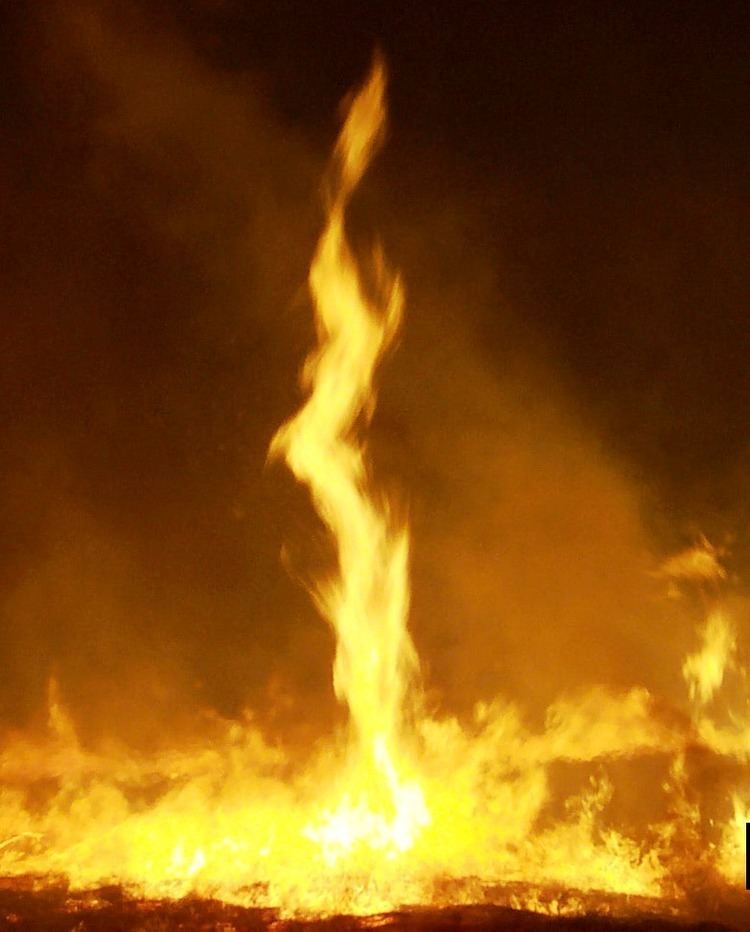 | ||
A fire whirl – also commonly known as a fire devil, fire tornado, firenado, or fire twister – is a whirlwind induced by a fire and often made up of flame or ash. Fire whirls may occur when intense rising heat and turbulent wind conditions combine to form whirling eddies of air. These eddies can contract into a tornado-like structure that sucks in burning debris and combustible gases.
Contents
Fire whirls are sometimes colloquially called fire tornadoes, but are not literally tornadoes, in that their vorticity derives from surface winds and heat-induced lifting, rather than a tornadic mesocyclone aloft.
The literal fire tornado is a rare phenomenon, much more powerful and destructive than the ordinary fire whirl, in which the wildfire generates a pyrocumulonimbus cloud that then spawns a tornado. When this tornado forms in or enters the fire zone, it fans flames enormously, draws flame and burning debris into itself, and scatters burning debris over a wide area.
A fire tornado is generated by the fire's own effect on local airflow, as with any fire whirl, but indirectly and by a different route. The fire also has to be enormous in order to create a pyrocumulonimbus cloud powerful enough for it to be classified as a supercell thunderstorm. Then the conditions have to be just right in order for a fire tornado to form.
Formation
A fire whirl consists of a core – the part that is actually on fire – and an invisible rotating pocket of air. A fire whirl can reach up to 2,000 °F (1,090 °C) – hot enough to potentially reignite ashes sucked up from the ground. Often, fire whirls are created when a wildfire or firestorm creates its own wind, which can turn into a spinning vortex of flame.
Combustible, carbon-rich gases released by burning vegetation on the ground are fuel for most fire whirls. When sucked up by a whirl of air, this unburned gas travels up the core until it reaches a region where there is enough fresh, heated oxygen to set it ablaze. This causes the tall and skinny appearance of a fire whirl's core.
Real-world fire whirls usually move fairly slowly. Fire whirls can set objects in their paths ablaze and can hurl burning debris out into their surroundings. The winds generated by a fire whirl can also be dangerous. Large fire whirls can create wind speeds of more than 100 mph (160 km/h) – strong enough to knock down trees – and people who get caught by a fire whirl can be burned alive.
Fire whirls can last for an hour or more, and they cannot be extinguished directly.
Examples
During the 2003 Canberra bushfires, a fire whirl on Mount Taylor with a diameter of nearly 500 metres (1,600 ft) with horizontal winds exceeding 250 km/h (160 mph) was documented. Further research into the fires confirmed this in 2012. In Canberra, wind damage consistent with an F2 tornado on the Fujita Scale was observed, in addition to the fire damage. New research released in 2013 showed that the supercell thunderstorm that caused the tornado originated from the converging winds of the firestorm itself, one of the first confirmed observations of an intense thunderstorm forming from a pyrocumulonimbus cloud.
Another extreme example of a fire tornado is the 1923 Great Kantō earthquake in Japan which ignited a large city-sized firestorm and produced a gigantic fire whirl that killed 38,000 people in fifteen minutes in the Hifukusho-Ato region of Tokyo.
Another example is the numerous large fire whirls (some tornadic) that developed after lightning struck an oil storage facility near San Luis Obispo, California on 7 April 1926, several of which produced significant structural damage well away from the fire, killing two. Many whirlwinds were produced by the four-day-long firestorm coincident with conditions that produced severe thunderstorms, in which the larger fire whirls carried debris 5 kilometers away.
A fire tornado, uncommon in New Zealand wildfires, formed on day three of the 2017 Port Hills fires in Christchurch. Pilots estimated the fire column to be 100 metres (330 ft) high.
Classification
There are currently three known types of fire whirls:
There is evidence suggesting that the fire whirl in the Hifukusho-ato area, during the Great Kanto Earthquake of 1923, was of type 3.
